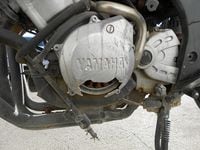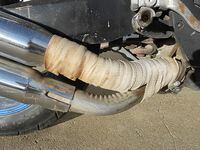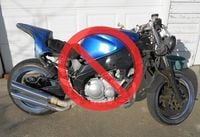So you want to trade in your bike for something newer. You roll up to my dealership, paperwork in hand, ready to deal. As part of this transaction, I will inspect your machine to help determine a trade-in value. There are many ways to add value to your bike. Just as important, here are 10 ways to detract from it.
1. Missing parts. Making a bike lighter can make it go a little faster, but cutting the exhaust off behind the header pipes and tossing out the rest not only ruins performance, but the exhaust will have to be replaced. Loud does not equate to fast. Removing mirrors and turn signals might make you anti-establishment, but we can't resell your trade-in without them, so if you decide to remove these bits, you might want to keep them handy.
2. Altering appearance. If you feel the urge to pick up a can of spray paint to give your bike the "murdered-out" look, please seek counseling. If you follow through with the rattle-can paint job, you just killed your bike's trade-in value. At least remove tank emblems, stickers, and bugs before you go at it. Oh, and feel free to mask off what you don't want to paint. Over-spray is not custom, and roll-on bed liner is for truck beds, not gas tanks.
3. Crash damage. It doesn't matter if you bought it this way or your friend's brother did it—it's still wrecked. You wouldn't buy a wrecked bike from a dealer, so what makes you think we can sell it in this condition? Also, spray paint won't hide the damage.
4. Stickers. Although stickers can be removed, it's important to note where they are located. Windshields or windscreens are not a good place to put something that's going to require heat or a razor blade to get off. Painted surfaces are a little better, but it comes back to how hard it is to remove. Time and effort come into play when it is being made ready for sale.
5. Heavy modifications. This can be anything from the engine to the chassis to the paint. If you convert your cruiser to a rigid frame or the engine has a turbo added and can only be ridden a quarter mile at a time, we might have a problem. Keep in mind it's all about appeal. Your trade-in needs to appeal to a larger crowd than the one standing around your bike saying, "How could he do that to a perfectly good motorcycle?" If you are a custom-bike builder with a shelf full of trophies, you're good; unless you want to trade it in as well.
6. Unpopular or discontinued models. I know what you're thinking: It's a collectible, right? In some cases this is true, but in most cases if it wasn't desirable when it was new, it still isn't. You might want to try to sell it on Craigslist.
7. Mileage. I for one ride a lot of miles. The last motorcycle I traded in had 75,000 miles on it, and my current motorcycle has 70K. I can appreciate someone who rides gets full enjoyment out of his bike. That's why you own it. But all the used bikes out there with fewer miles will definitely influence a high-mileage bike's trade-in value.
8. Craigslist. Think about it for a minute. You are listing your motorcycle for sale online in hopes of buying another bike you have your sights on at a dealership. You wait patiently but can't get any potential buyers, so you decide to bite the bullet and trade it in. Sellers are often honest with their bike's shortcomings when they list it online, disclosing mechanical issues, crash damage, electrical problems, etc. We actually look at Craigslist every day to see what's for sale, knowing that bikes listed online might be traded in. You knew it had a knock in the engine when you listed it, but now it's news to you. Sorry. That won't fly.
9. Cheap bolt-ons. If it does not have a brand name, it's cheap. We're talking about those overseas E-bay specials on anything from LED turn signals to batteries and other electrical components that are mass-produced to look like quality products. But aren't. Granted some of the no-name stuff isn't bad, but when it comes to selling the bike, the cheap stuff will count against the overall value of the motorcycle.
10. General condition. Common sense tells you that a poorly maintained bike is not going to be reliable transportation and will most likely require some work to bring it up to safe standards. A kinked chain, bald tires, cracked engine covers, rusted parts, bent handlebars, torn seat or no oil. The list can go on and on, and by the way, how did you get here on that thing anyway?
So what do we want? Clean, well cared for, as stock as possible. If you have all the paperwork dating to the original sale and a documented service history, so much the better. We’ll pay more for a bike we don’t have to thoroughly go through than one we must refurbish before sale. It’s that simple.
Jeff Maddox is the sales manager for a multi-line dealership in the Midwest. Questions for him? Email us at mcmail@bonniercorp.com with "Retail Confidential" in the subject line.















/cloudfront-us-east-1.images.arcpublishing.com/octane/ITNLTIU5QZARHO733XP4EBTNVE.jpg)
/cloudfront-us-east-1.images.arcpublishing.com/octane/VZZXJQ6U3FESFPZCBVXKFSUG4A.jpg)
/cloudfront-us-east-1.images.arcpublishing.com/octane/QCZEPHQAMRHZPLHTDJBIJVWL3M.jpg)
/cloudfront-us-east-1.images.arcpublishing.com/octane/HXOUJXQWA5HBHGRO3EMJIGFMVI.jpg)

/cloudfront-us-east-1.images.arcpublishing.com/octane/3TIWWRV4JBBOLDVGRYECVVTA7Y.jpg)
/cloudfront-us-east-1.images.arcpublishing.com/octane/KIX5O23D5NAIBGFXBN3327DKZU.jpg)
/cloudfront-us-east-1.images.arcpublishing.com/octane/7GJYDUIPXRGMTMQKN6ONYOLBOU.jpg)
/cloudfront-us-east-1.images.arcpublishing.com/octane/MUQLOVLL2ZDGFH25ILABNBXKTI.jpg)
/cloudfront-us-east-1.images.arcpublishing.com/octane/TNOU5DNE2BC57MFPMGN2EIDXAM.jpg)
/cloudfront-us-east-1.images.arcpublishing.com/octane/GTCXACQGJ5HAPDTGWUQKDEH44E.jpg)
/cloudfront-us-east-1.images.arcpublishing.com/octane/S35YGSEMEZB4BLTDJTSZPF4GLA.jpg)
/cloudfront-us-east-1.images.arcpublishing.com/octane/5UOT6HPX2JFMRJAX6EH45AR4MQ.jpg)
/cloudfront-us-east-1.images.arcpublishing.com/octane/OKWOJWAKP5EP3OACCRRWPCIX2Q.jpg)
/cloudfront-us-east-1.images.arcpublishing.com/octane/2WF3SCE3NFBQXLDNJM7KMXA45E.jpg)
/cloudfront-us-east-1.images.arcpublishing.com/octane/G4MG6OUCJNBSHIS2MVVOTPX65E.jpg)
/cloudfront-us-east-1.images.arcpublishing.com/octane/IIGGWFOTOJGB7DB6DGBXCCMTDY.jpg)
/cloudfront-us-east-1.images.arcpublishing.com/octane/QSTCM6AVEZA5JJBUXNIQ3DSOF4.jpg)
/cloudfront-us-east-1.images.arcpublishing.com/octane/U4I7G625B5DMLF2DVIJDFZVV6M.jpg)
/cloudfront-us-east-1.images.arcpublishing.com/octane/B6XD6LS6IVCQPIU6HXDJSM3FHY.jpg)
/cloudfront-us-east-1.images.arcpublishing.com/octane/ICL63FEDDRDTTMINYICCEYGMDA.jpg)
/cloudfront-us-east-1.images.arcpublishing.com/octane/FCGZHQXRBZFLBAPC5SDIQLVF4I.jpg)
/cloudfront-us-east-1.images.arcpublishing.com/octane/WNOB6LDOIFFHJKPSVIWDYUGOPM.jpg)
